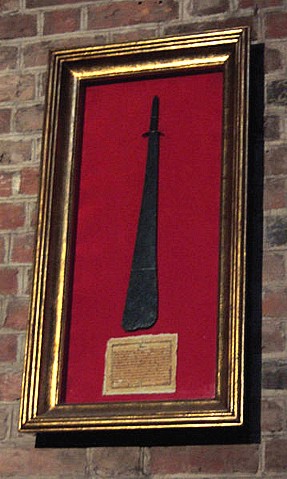Lessico
Malco
In the Gospel of John in the New Testament of the Bible, Malchus is the name of the High Priest's servant, who participated in the arrest of Jesus. One of the disciples, Peter according to John, being armed with a sword, cut off the servant's ear in an attempt to prevent his Master's arrest.
The story is related in all four gospels, John 18:10–11; Matthew 26:51; Mark 14:47; and Luke 22:51, but the servant and the disciple are named only in John. Also, Luke is the only gospel that says Jesus healed the ear. The relevant passage in the Gospel of John, KJV, reads:
Then Simon Peter having a sword drew it, and smote the high priest's servant, and cut off his right ear. The servant's name was Malchus. Then said Jesus unto Peter, Put up thy sword into the scabbard: the cup which my Father hath given me, shall I not drink it?
The story is often used to illustrate Jesus' rejection of violence and surrender to God's will.
Málchos
Greek form of Malluch (i.e. counsellor), a name common in the Semitic languages and of special interest as being that borne by the Jewish servant whose ear was struck off by St. Peter.
The incident is described by all the Evangelists (Matthew 26:51; Mark 14:47; Luke 22:50; John 18:10), though St. John alone furnishes us the names of the servant and the disciple, and only St. Luke mentions the miraculous healing of the injury. According to the Fourth Gospel, Judas, accompanied by a band of soldiers and servants sent out by the high-priests and Pharisees, set out from the city to apprehend Jesus. After the meeting, when the soldiers were about to seize Jesus, St. Peter drew his sword and cut off the right ear of a servant of the high-priest. We may conclude that Malchus was in the van of the hostile party and showing particular zeal, for St. Peter would hardly have singled him out without reason. Christ at once healed the wound and took occasion to teach His followers a lesson of peace.
Later in the evening a servant, related to Malchus, wrung the second denial from St. Peter (John 18:26-27). Since St. John alone gives the name of the servant, we may conclude that he himself was the disciple known to the high priest (John 18:15). The silence of the other sacred writers with regard to Peter's identity may be ascribed to a motive of prudence, for at the time they wrote the Jews might have punished the disciple, had they known his name.
Catholic Encyclopedia
Saint Peter's Sword

The
copy of St. Peter's Sword
displayed in Poznan Archcathedral
The Sword of Saint Peter (Polish: Miecz swietego Piotra) is allegedly the sword with which the Apostle Peter cut off the ear of the high priest's servant at the time of Jesus' arrest in Gethsemane. The sword is wide-tipped, similar in shape to a dussack or machete. It currently resides in the Poznan Archdiocesan Museum. An exact copy of the sword, made by Bogdan Puchalski, is displayed on the wall of the Poznan Archcathedral Basilica.
The sword is mentioned for the first time in the 1609 Vitae Episcoporum Posnaniensium of Jan Dlugosz as being the original Roman sword used by Saint Peter in the Gospels, or a direct copy made for Pope Stephen VII. However, at this time Stephen was already dead, and the current pope was John XIII.
The sword arrived in Poznan in 968 as a gift from John XIII for either Bishop Jordan or Duke Mieszko I. The Archdeacon of Poznan Cathedral in 1699 writes about the sword, describing it as a part of St. Peter's sword brought to Poznan by Bishop Jordan, where it is usually kept in the cathedral treasury, except for the few times a year when it is shown to the people. The 1721 Decree of Poznan Cathedral Chapter refers to having the sword moved to the chapter house as a more proper placement for this noble artefact.
For many years, historians treated the sword as a copy, probably made in the 10th century, but research by scientists from the Polish Army Museum in Warsaw suggests that the weapon could have been made in the 1st century in the eastern borderlands of the Roman Empire. However, scientists from the Greater Poland Army Museum in Poznan strongly consider it to be a medieval copy. Other experts, like Marian Glosek and Leszek Kajzer, suggest that the sword was made in the first quarter of the 14th century. Regardless of when the sword was made, it has the longest documented history in Poland, along with the Szczerbiec.
The blade was made from a single piece of iron with an added small cross-guard. Total length: 70.2-centimetre (27.6 in), it was probably 1-centimetre (0.4 in) or 2-centimetre (0.8 in) longer, but the tip of the sword was destroyed by corrosion. Maximal width, at the tip: 9.4-centimetre (3.7 in). There is a hole 10.3-centimetre (4.1 in) from the end of the hilt, which is 0.4-centimetre (0.2 in) in diameter.